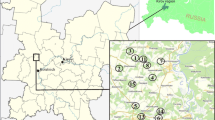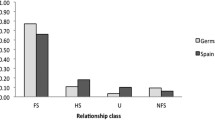Abstract
Accurate estimates of male reproductive success are essential to understanding the evolution of polyandrous mating systems. Here, we use multilocus DNA fingerpinting to assess parentage in an island population of Tasmanian native hens (Tribonyx mortierii), which often live in multi-male and/or multi-female social groups. This isolated population presented special challenges to this technique because it was artificially founded from a small number of individuals in the recent past. DNA profiles from four multilocus minisatellite probes were analyzed for adults and offspring from six social groups using two methods: (1) significance of band-sharing coefficients and (2) distribution among a group's offspring of fragments unique to certain adults. Traditional band-sharing analyses did not provide sufficient resolution to establish parentage in this population due to the high level of band-sharing between adults within groups. In contrast, the distribution of unique fragments suggests that in most cases, all offspring within a group have the same male and female genetic parents, so that monogamy may be the predominant “genetic” mating system of this species. This forces a rexamination of the evolutionary basis of polyandry in these birds. It also demonstrates some of the difficulties in using these highly polymorphic genetic markers for parentage analyses when putative parents are closely related.
Similar content being viewed by others

References
Brock K, While BN (1991) Multifragment alleles in DNA fingerprints of the parrot (Amazona ventralis). J Heredity 82:209–212
Brock K, White BN (1992) Application of DNA fingerprinting to the recovery program of the endangered Puerto Rican parrot. Proc Natl Acad Sci USA 89:11121–11125
Brown JL (1987) Helping and communal breeding in birds. Princeton University Press, Princeton
Bruford MW, Hanotte O, Brookfield JFY, Burke T (1992) Single locus and multilocus DNA fingerprints. In: Hoelzel A (ed) Molecular genetic analysis of populations. A practical approach. IRL Press, Oxford, pp 225–269
Burke T, Bruford M (1987) DNA fingerprinting in birds. Nature 327:149–152
Burke T, Davies NB, Bruford MW, Hatchwell BJ (1989) Parental care of polyandrous dunnocks Prunella modularis related to paternity by DNA fingerprinting. Nature 338:249–251
Galbraith D, Boag PT, Gibbs HL, White BN (1991) Sizing bands on autoradiographs: a study of precision for scoring DNA fingerprints. Electrophoresis 12:210–220
Gibbs HL, Weatherhead PJ, Boag PT, White BN (1990) Realized reproductive success in polygynous red-winged blackbirds. Science 250:253–263
Goldizen AW, Goldizen AR, Devlin T (1993) Unstable social strucutre associated with a population crash in the Tasmanian native hen Tribonyx mortierii. Anim Behav 46:1013–1016
Gowaty PA, Gibbs HL (1993) DNA fingerprinting in avian behavioural ecology: two cultures arise. Auk 110:152–155
Gyllensten UB, Jakobsson S, Temrin H (1990) No evidence for illegitimate young in monogamous and polygynous warblers. Nature 343:168–170
Haig SB, Beltoff JR, Allen DH (1993) Examination of population structure in red-cockaded woodpeckers using DNA profiling. Evolution 47:185–194
Jeffreys AJ, Wilson V, Thein SL (1985) Individual specific fingerprints of human DNA. Nature 314:67–73
Lifjeld JT, Dunn PO, Robertson RJ, Boag PT (1993) Extrapair paternity in monogamous tree swallows. Anim Behav 45:213–229
Maynard Smith JM, Ridpath MG (1972) Wife sharing in the Tasmanian native hen, Tribonyx mortierii: a case of kin selection? Am Nat 106:447–452
Quinn TW, Quinn JS, Cooke F, White BN (1987) DNA marker analysis detects multiple maternity and paternity in single broods of the lesser snow goose. Nature 326:392–347
Quinn TW, Davies JC, Cooke F, White BN (1989) Genetic analysis of offspring of a female-female pair in the lesser snow goose (Chen c. caerulescens). Auk 106:177–184
Rabenold PP, Rabenold KN, Piper WH, Haydock J, Zack SW (1990) Shared paternity revealed by genetic analysis in cooperatively breeding tropical wrens. Nature 348:538–540
Reeders ST, Breuning MH, Davies KE, Nicholls RD, Jarman AP, Higgs DR, Weatherall DJ (1985) A highly polymorphic marker linked to adult polycystic kidney disease on chromosome 16. Nature 317:542–544
Rico C, Kuhnlein U, Fitzgerald GJ (1992) Male reproductive tactics in the threespined stickleback — an evaluation by DNA fingerprinting. Mol Ecol 1:79–87
Ridpath MG (1972) The Tasmanian native hen, I-III. CSIRO Wildlife Research 17:1–118
Schlotterer C, Amos B, Tautz D (1991) Conservation of polymorphic simple sequence loci in cetacean species. Nature 354:63–65
Seutin G, White BN, Boag PT (1991) Preservation of avian blood and tissue samples for DNA analyses. Can J Zool 69:82–90
Shin H-S, Bargiello TA, Clark BT, Jackson FR, Young MW (1985) An unusual coding sequence from a Drosophila clock gene is conserved in vertebrates. Nature 317:445–448
Tautz D (1989) Hypervariability of simple sequences as a general source of polymorphic markers. Nucl Acids Res 17:6463–6471
Vassart G, Georges M, Monsieur R, Brocas H, Lequarre AS, Christophe D (1987) A sequence of M13 detects hypervariable minisatellites in human and animal DNA. Science 235:683–684
Westneat DF (1990) Genetic parentage in the indigo bunting: a study using DNA fingerprinting. Behav Ecol Sociobiol 27:67–76
Westneat DF (1993) Polygyny and extrapair fertilizations in eastern red-winged blackbirds Agelaus phoeniceus. Behav Ecol 4:49–60
Westneat DF, Noon WA, Hudson KR, Aquadro CF (1988) Improved hybridization conditions for DNA fingerprints probed with M13. Nuc Acids Res 16:41–61
Wetton JH, Carter RE, Parkin DT, Walters D (1987) Demographic study of a wild house sparrow population by DNA fingerprinting. Nature 327:147–149
Goldizen AW, Goldizen AR, Devlin T (1993) Unstable social strucutre associated with a population crash in the Tasmanian native hen Tribonyx mortierii. Anim Behav 46:1013–1016
Gowaty PA, Gibbs HL (1993) DNA fingerprinting in avian behavioural ecology: two cultures arise. Auk 110:152–155
Gyllensten UB, Jakobsson S, Temrin H (1990) No evidence for illegitimate young in monogamous and polygynous warblers. Nature 343:168–170
Haig SB, Beltoff JR, Allen DH (1993) Examination of population structure in red-cockaded woodpeckers using DNA profiling. Evolution 47:185–194
Jeffreys AJ, Wilson V, Thein SL (1985) Individual specific fingerprints of human DNA. Nature 314:67–73
Lifjeld JT, Dunn PO, Robertson RJ, Boag PT (1993) Extrapair paternity in monogamous tree swallows. Anim Behav 45:213–229
Maynard Smith JM, Ridpath MG (1972) Wife sharing in the Tasmanian native hen, Tribonyx mortierii: a case of kin selection? Am Nat 106:447–452
Quinn TW, Quinn JS, Cooke F, White BN (1987) DNA marker analysis detects multiple maternity and paternity in single broods of the lesser snow goose. Nature 326:392–347
Quinn TW, Davies JC, Cooke F, White BN (1989) Genetic analysis of offspring of a female-female pair in the lesser snow goose (Chen c. caerulescens). Auk 106:177–184
Rabenold PP, Rabenold KN, Piper WH, Haydock J, Zack SW (1990) Shared paternity revealed by genetic analysis in cooperatively breeding tropical wrens. Nature 348:538–540
Reeders ST, Breuning MH, Davies KE, Nicholls RD, Jarman AP, Higgs DR, Weatherall DJ (1985) A highly polymorphic marker linked to adult polycystic kidney disease on chromosome 16. Nature 317:542–544
Rico C, Kuhnlein U, Fitzgerald GJ (1992) Male reproductive tactics in the threespined stickleback — an evaluation by DNA fingerprinting. Mol Ecol 1:79–87
Ridpath MG (1972) The Tasmanian native hen, I–III. CSIRO Wildlife Research 17:1–118
Schlotterer C, Amos B, Tautz D (1991) Conservation of polymorphic simple sequence loci in cetacean species. Nature 354:63–65
Seutin G, White BN, Boag PT (1991) Preservation of avian blood and tissue samples for DNA analyses. Can J Zool 69:82–90
Shin H-S, Bargiello TA, Clark BT, Jackson FR, Young MW (1985) An unusual coding sequence from a Drosophila clock gene is conserved in vertebrates. Nature 317:445–448
Tautz D (1989) Hypervariability of simple sequences as a general source of polymorphic markers. Nucl Acids Res 17:6463–6471
Vassart G, Georges M, Monsieur R, Brocas H, Lequarre AS, Christophe D (1987) A sequence of M13 detects hypervariable minisatellites in human and animal DNA. Science 235:683–684
Westneat DF (1990) Genetic parentage in the indigo bunting: a study using DNA fingerprinting. Behav Ecol Sociobiol 27:67–76
Westneat DF (1993) Polygyny and extrapair fertilizations in eastern red-winged blackbirds Agelaus phoeniceus. Behav Ecol 4:49–60
Westneat DF, Noon WA, Hudson KR, Aquadro CF (1988) Improved hybridization conditions for DNA fingerprints probed with M13. Nuc Acids Res 16:41–61
Wetton JH, Carter RE, Parkin DT, Walters D (1987) Demographic study of a wild house sparrow population by DNA fingerprinting. Nature 327:147–149
Author information
Authors and Affiliations
Rights and permissions
About this article
Cite this article
Lisle Gibbs, H., Goldizen, A.W., Bullough, C. et al. Parentage analysis of multi-male social groups of tasmanian native hens (Tribonyx mortierii): genetic evidence for monogamy and polyandry. Behav Ecol Sociobiol 35, 363–371 (1994). https://doi.org/10.1007/BF00184425
Received:
Accepted:
Issue Date:
DOI: https://doi.org/10.1007/BF00184425



